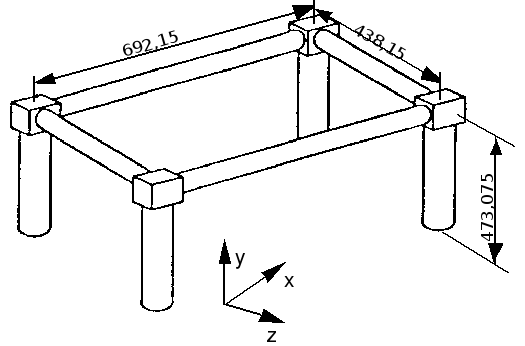1. Reference problem#
1.1. Geometry#

\(L=0.69215m\)
\(l=0.43815m\)
\(H=0.473075m\)
Hollow circular section:
\({d}_{e}=0.060m\)
\({d}_{i}=0.052m\)
\(S=0.7037{10}^{-3}{m}^{2}\)
\({I}_{y}={I}_{z}=0.2772{10}^{-6}{m}^{4}\)
\({A}_{y}={A}_{z}=2.\)
\({C}_{y}=0.5545{10}^{-6}{m}^{4}\)
1.2. Material properties#
\(E=1.92276\mathrm{E11}N/{m}^{2}\)
\(\nu =0.3\)
\(\rho =7800.0\mathrm{kg}/{m}^{3}\)
Four masses of \(4.444\mathrm{kg}\) are located at the four upper vertices, see figure.
1.3. Boundary conditions and loads#
Structure embedded at its base,
Modal amortizations from \(\text{2 \%}\).
Definition of the acceleration spectrum at the supports
Frequency |
\(X\) \(Z\) |
|
100 |
17.3 |
11.5 |
110 |
16.3 |
10.9 |
120 |
15.3 |
10.2 |
130 |
14.3 |
9.6 |
300 |
10.2 |
6.66 |
for an amortization of \(\text{2 \%}\),
acceleration in \(g\).